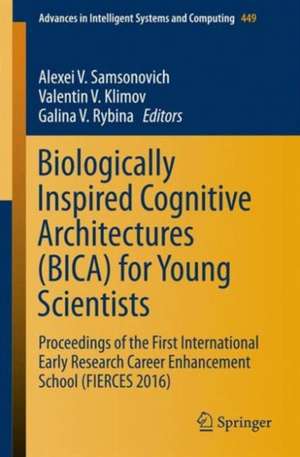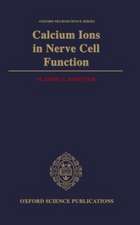Biologically Inspired Cognitive Architectures (BICA) for Young Scientists: Proceedings of the First International Early Research Career Enhancement School (FIERCES 2016): Advances in Intelligent Systems and Computing, cartea 449
Editat de Alexei V. Samsonovich, Valentin V. Klimov, Galina V. Rybinaen Limba Engleză Paperback – 31 mar 2016
Din seria Advances in Intelligent Systems and Computing
- 20%
 Preț: 1120.90 lei
Preț: 1120.90 lei - 20%
 Preț: 1090.59 lei
Preț: 1090.59 lei - 20%
 Preț: 1324.07 lei
Preț: 1324.07 lei - 20%
 Preț: 1989.79 lei
Preț: 1989.79 lei - 20%
 Preț: 1946.92 lei
Preț: 1946.92 lei - 18%
 Preț: 1273.28 lei
Preț: 1273.28 lei - 20%
 Preț: 2264.51 lei
Preț: 2264.51 lei - 20%
 Preț: 1337.27 lei
Preț: 1337.27 lei - 20%
 Preț: 1297.67 lei
Preț: 1297.67 lei - 20%
 Preț: 1315.82 lei
Preț: 1315.82 lei - 20%
 Preț: 1310.88 lei
Preț: 1310.88 lei - 20%
 Preț: 1302.62 lei
Preț: 1302.62 lei - 20%
 Preț: 882.20 lei
Preț: 882.20 lei - 20%
 Preț: 1305.93 lei
Preț: 1305.93 lei - 20%
 Preț: 1629.32 lei
Preț: 1629.32 lei - 20%
 Preț: 1345.49 lei
Preț: 1345.49 lei - 18%
 Preț: 1227.52 lei
Preț: 1227.52 lei - 18%
 Preț: 1290.64 lei
Preț: 1290.64 lei - 20%
 Preț: 1041.10 lei
Preț: 1041.10 lei - 20%
 Preț: 1034.52 lei
Preț: 1034.52 lei - 20%
 Preț: 1298.50 lei
Preț: 1298.50 lei - 20%
 Preț: 1330.67 lei
Preț: 1330.67 lei - 20%
 Preț: 1483.28 lei
Preț: 1483.28 lei - 20%
 Preț: 1971.64 lei
Preț: 1971.64 lei - 20%
 Preț: 1006.48 lei
Preț: 1006.48 lei - 20%
 Preț: 1471.75 lei
Preț: 1471.75 lei - 20%
 Preț: 1471.56 lei
Preț: 1471.56 lei - 20%
 Preț: 1454.40 lei
Preț: 1454.40 lei - 20%
 Preț: 1494.84 lei
Preț: 1494.84 lei - 20%
 Preț: 1269.64 lei
Preț: 1269.64 lei - 20%
 Preț: 1481.64 lei
Preț: 1481.64 lei - 20%
 Preț: 1192.08 lei
Preț: 1192.08 lei - 20%
 Preț: 1298.50 lei
Preț: 1298.50 lei - 20%
 Preț: 1489.07 lei
Preț: 1489.07 lei - 20%
 Preț: 825.78 lei
Preț: 825.78 lei - 20%
 Preț: 1649.93 lei
Preț: 1649.93 lei - 20%
 Preț: 1463.49 lei
Preț: 1463.49 lei - 20%
 Preț: 1438.77 lei
Preț: 1438.77 lei - 20%
 Preț: 1474.22 lei
Preț: 1474.22 lei - 20%
 Preț: 1298.50 lei
Preț: 1298.50 lei - 20%
 Preț: 1327.35 lei
Preț: 1327.35 lei - 20%
 Preț: 1973.31 lei
Preț: 1973.31 lei - 18%
 Preț: 947.04 lei
Preț: 947.04 lei - 18%
 Preț: 1441.39 lei
Preț: 1441.39 lei - 20%
 Preț: 638.55 lei
Preț: 638.55 lei - 20%
 Preț: 1320.76 lei
Preț: 1320.76 lei - 20%
 Preț: 1948.56 lei
Preț: 1948.56 lei
Preț: 988.00 lei
Preț vechi: 1235.00 lei
-20% Nou
Puncte Express: 1482
Preț estimativ în valută:
189.04€ • 197.40$ • 156.11£
189.04€ • 197.40$ • 156.11£
Carte tipărită la comandă
Livrare economică 15-29 aprilie
Preluare comenzi: 021 569.72.76
Specificații
ISBN-13: 9783319325538
ISBN-10: 3319325531
Pagini: 306
Ilustrații: X, 306 p. 74 illus., 6 illus. in color.
Dimensiuni: 155 x 235 mm
Greutate: 0.45 kg
Ediția:1st ed. 2016
Editura: Springer International Publishing
Colecția Springer
Seria Advances in Intelligent Systems and Computing
Locul publicării:Cham, Switzerland
ISBN-10: 3319325531
Pagini: 306
Ilustrații: X, 306 p. 74 illus., 6 illus. in color.
Dimensiuni: 155 x 235 mm
Greutate: 0.45 kg
Ediția:1st ed. 2016
Editura: Springer International Publishing
Colecția Springer
Seria Advances in Intelligent Systems and Computing
Locul publicării:Cham, Switzerland
Cuprins
Models of Autonomous Cognitive Agents.- Differentiationof Groundwater Tax Rates as an Element of Improving the Economic Mechanism inthe State Groundwater Extraction Management.- Users' of Information SystemsProtection Analysis from Malefactor's Social Engineering Attacks Taking into AccountMalefactor's Competence Profile.- Character Reasoning of the Social NetworkUsers on the Basis of the Content Contained on Their Personal Pages.- BayesianOptimization of Spiking Neural Network Parameters to Solving the Time SeriesClassiffcation Task.- Simulation of Learning in Neuronal Culture.- UnsupervisedNeural Architecture for Saliency Detection: Extended Version.- Active adaptationof expert-based suggestions in ladieswear recommender system LookBooksClub via ReinforcementLearning.- Visual Analytics Support for Carbon Nanotube Design Automation.- Amodel of Neurodynamics of Hippocampal Formation Neurons Performing SpatialProcessing Based on Even Cyclic Inhibitory Networks.- Feature Selection for Time-SeriesPrediction in Case of Undetermined
Estimation.- A New Approach for Semantic CognitiveMaps Creation and Evaluation
Based on Affix Relations.- On Alternative Instruments forthe fMRI Data Analysis: General Linear
Model Versus Algebraic Topology Approach.- Applicationof Hopfield Neural Network to the N-Queens Problem.- Simulation of a Fear-LikeState on a Model of Dopamine System of Rat Brain.- Spatial and TemporalParameters of Eye Movements
During Viewing of Affective Images.- MEG Data AnalysisUsing the Empirical Mode Decomposition Method.- Evolutional Approach to ImageProcessing on the Example of Microsections.- "Cognovisor" for the HumanBrain: Towards Mapping of Thought Processes by a Combination of fMRI and Eye-tracking.-Dynamic Intelligent Systems Integration and Evolution of Intelligent
Control Systems Architectures.- Automated Planning:Usage for Integrated Expert Systems Construction.- Some Aspects of TemporalKnowledge Acquisition and Representation in Dynamic Integrated Expert Systems.- Collaboration ofAll-purpose Static Solver, Temporal Reasoning and Simulation Modeling Tools inDynamic Integrated Expert Systems.- Some Aspects of Intellectual Tutoring Basedon the Integrated Tutoring Expert Systems Usage.- To the Question of Learnabilityof a Spiking Neuron with Spike-Timing-Dependent Plasticity in Case of ComplexInput Signals.- Causal Interactions Within the Default Mode Network as Revealedby Low-frequency Brain Fluctuations and Information Transfer Entropy.- HierarchicalTemporal Memory Implementation with Explicit States Extraction.- Swarm MeLiF:Feature Selection with Filter Combination Found via Swarm Intelligence.- Agent-basedModel of Interactions in the Community of Investors and Producers.- Patterns ofSpiking Activity of Neuronal Networks in Vitro as Memory Traces.- TheCompetency Management Based on Ontologies: Issues of Using in Organizations.- TheApproach to Modeling of Synchronized Bursting in Neuronal Culture Using a MathematicalModel of a Neuron with Autoregulation Mechanism.- Dynamic Clustering of ConnectionsBetween fMRI Resting State Networks: A Comparison of Two Methods of DataAnalysis.- Neural Network Solution of an Inverse Problem in Raman Spectroscopy ofMulti-Component Solutions of Inorganic Salts.- Prediction of RelativisticElectrons Flux in the Outer Radiation Belt of the Earth Using Adaptive Methods.-Comparative Analysis of Residual Minimization and Artificial Neural Networks asMethods of Solving Inverse Problems: Test on Model Data.- A BiologicallyInspired Architecture for Visual Self-Location.
Estimation.- A New Approach for Semantic CognitiveMaps Creation and Evaluation
Based on Affix Relations.- On Alternative Instruments forthe fMRI Data Analysis: General Linear
Model Versus Algebraic Topology Approach.- Applicationof Hopfield Neural Network to the N-Queens Problem.- Simulation of a Fear-LikeState on a Model of Dopamine System of Rat Brain.- Spatial and TemporalParameters of Eye Movements
During Viewing of Affective Images.- MEG Data AnalysisUsing the Empirical Mode Decomposition Method.- Evolutional Approach to ImageProcessing on the Example of Microsections.- "Cognovisor" for the HumanBrain: Towards Mapping of Thought Processes by a Combination of fMRI and Eye-tracking.-Dynamic Intelligent Systems Integration and Evolution of Intelligent
Control Systems Architectures.- Automated Planning:Usage for Integrated Expert Systems Construction.- Some Aspects of TemporalKnowledge Acquisition and Representation in Dynamic Integrated Expert Systems.- Collaboration ofAll-purpose Static Solver, Temporal Reasoning and Simulation Modeling Tools inDynamic Integrated Expert Systems.- Some Aspects of Intellectual Tutoring Basedon the Integrated Tutoring Expert Systems Usage.- To the Question of Learnabilityof a Spiking Neuron with Spike-Timing-Dependent Plasticity in Case of ComplexInput Signals.- Causal Interactions Within the Default Mode Network as Revealedby Low-frequency Brain Fluctuations and Information Transfer Entropy.- HierarchicalTemporal Memory Implementation with Explicit States Extraction.- Swarm MeLiF:Feature Selection with Filter Combination Found via Swarm Intelligence.- Agent-basedModel of Interactions in the Community of Investors and Producers.- Patterns ofSpiking Activity of Neuronal Networks in Vitro as Memory Traces.- TheCompetency Management Based on Ontologies: Issues of Using in Organizations.- TheApproach to Modeling of Synchronized Bursting in Neuronal Culture Using a MathematicalModel of a Neuron with Autoregulation Mechanism.- Dynamic Clustering of ConnectionsBetween fMRI Resting State Networks: A Comparison of Two Methods of DataAnalysis.- Neural Network Solution of an Inverse Problem in Raman Spectroscopy ofMulti-Component Solutions of Inorganic Salts.- Prediction of RelativisticElectrons Flux in the Outer Radiation Belt of the Earth Using Adaptive Methods.-Comparative Analysis of Residual Minimization and Artificial Neural Networks asMethods of Solving Inverse Problems: Test on Model Data.- A BiologicallyInspired Architecture for Visual Self-Location.
Textul de pe ultima copertă
This book presents cutting-edge research focused on current challenges towards the realization of Biologically Inspired intelligent agents, or Cognitive Architectures (BICA). The chapters are written by both world-recognized experts (including Antonio Chella, Olivier Georgeon, Oliver Kutz, Antonio Lieto, David Vernon, Paul Verschure, and others) and young researchers. Together, they constitute a good mixture of new findings with tutorial-based reviews and position papers, all presented at the First International Early Research Career Enhancement School on Biologically Inspired Cognitive Architectures (FIERCES on BICA 2016), held April 21-24 in Moscow, Russia. Most works included here cross boundaries between disciplines: from neuroscience to social science, from cognitive science to robotics, and from bioengineering to artificial intelligence. A special emphasis is given to novel solutions to urgent problems that have been resisting traditional approaches for decades. Intended for providing readers with an update on biologically inspired approaches towards the computational replication of all the essential aspects of the human mind (the BICA Challenge), this book is expected to foster lively discussions on the topic and stimulate cross-disciplinary, cross-generation and cross-cultural collaboration.
Caracteristici
Reports on cutting-edge topics on biologically inspired cognitive architectures Offers a snapshot of current research towards computational replication of the human mind Bridges together different disciplines, including engineering, computer science and biology Includes supplementary material: sn.pub/extras











